Figure 5.
Schistosoma mansoni development in recombination activating gene (RAG)–1–deficient (RAG-1−/−) mice reconstituted with CD4+CD25− and CD4+CD25+ T cells from wild-type donors. One day before infection, RAG-1−/− recipients were reconstituted with 4 × 106 CD4+CD25− or CD4+CD25+ T cells from wild-type donors, and S. mansoni worm development and egg production were assessed at 6 weeks after infection. A, Length of male S. mansoni worms isolated from RAG-1−/− recipients reconstituted with PBS alone, CD4+CD25− T cells, or CD4+CD25+ T cells; overall P < .0001, Kruskal-Wallis test. B, Percentage of female worms participating in pairs in RAG-1−/− recipients reconstituted with PBS alone, CD4+CD25− T cells, or CD4+CD25+ T cells; overall P = .0306, Kruskal-Wallis test. C, No. of eggs deposited per pair of worms in the livers of RAG-1−/− recipients reconstituted with PBS alone, CD4+CD25− T cells, or CD4+CD25+ T cells; overall P = .0266, Kruskal-Wallis test. In panels A, B, and C, P values for each experimental group pair were calculated using Dunn’s multiple comparison test.

